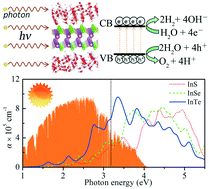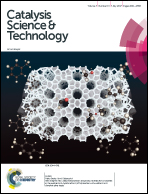Computational mining of photocatalysts for water splitting hydrogen production: two-dimensional InSe-family monolayers†
Abstract
Strongly suppressed recombination of electron–hole pairs, unexpectedly high carrier mobility, and anomalous optical response were found in an atomically thin indium selenide (InSe) photocatalyst. In this study, we unraveled the photocatalytic potential of two-dimensional (2D) InSe-family group-III monochalcogenide MX (M = Ga and In and X = S, Se, and Te) monolayers as water splitting hydrogen production photocatalysts on the basis of density functional theory. Our results not only highlight the high electron mobility and small exciton binding energy of 2D InSe, but also demonstrate the energy evolution of the adsorption and decomposition of water molecules as well as the hydrogen production process at the 2D InSe surface. The excellent stability of the MX monolayers was confirmed using lattice dynamical calculations as well as the ab initio molecular dynamics simulations in vacuum and aqueous environments. Moreover, distinguished optical absorption performance of the MX monolayers resulted in effective sunlight energy conversion as high as 1.20%, 6.40%, and 3.22% for the InSe, InTe, and GaTe monolayers, respectively.



 Please wait while we load your content...
Please wait while we load your content...